Glendale-Hyperion Bridge
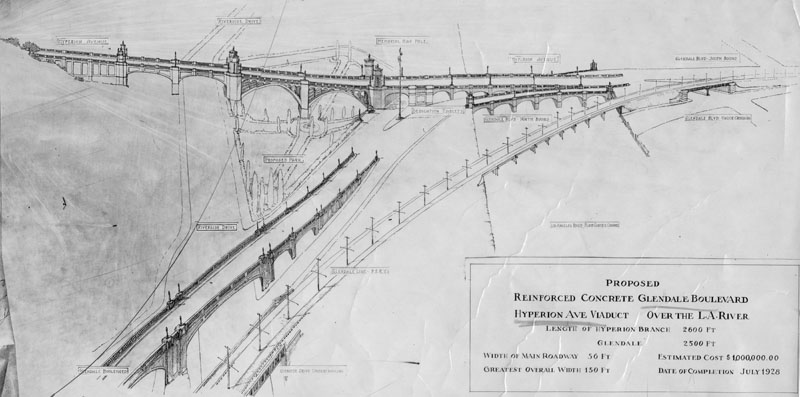 |
|
| (1927)^ - Artist's drawing on November 2, 1927, of the Hyperion Avenue viaduct over the Los Angeles River and proposed reinforced concrete Glendale Blvd. The length of the Hyperion branch is 2600 feet, the Glendale branch 2500 feet. Width of the main roadway is 50 feet, with the greatest overall width 150 feet. Estimated cost is one million dollars, and date of completion February 1929. Note the Pacfic Electric Line running on its own bridge adjacent to the Hyperion Bridge. |
Historical Notes Before the building of the Glendale-Hyperion Bridge there was a wooden bridge occupying where it now stands. The bridge that was built around 1910 served as the main entrance to Atwater Village. After a large flood in 1927 the old wooden bridge collapsed into the water.^* |
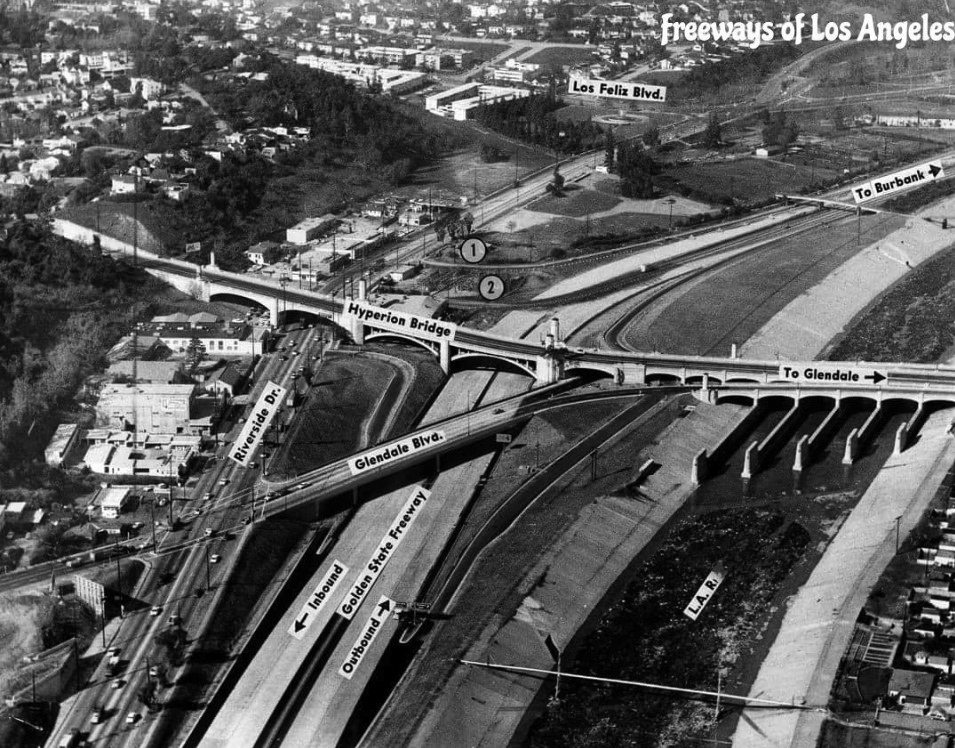 |
|
| (n.d.)** - Aerial view showing the Glendale-Hyperion Viaduct annotated to show street names, with the LA River seen on the right. Note: The Golden State Freeway was built years after (1950s) the completion of the viaduct. |
Historical Notes The Glendale-Hyperion Bridge was constructed in 1927 by vote of the citizens that lived in Atwater Village at the time, and was completed in February 1929. The bridge spans 400 feet over the Atwater section of the Los Angeles River and has 4 car lanes. The bridge has become more widely known because of existence of a small-scale replica of it at Disney California Adventure Park in Anaheim, California.^* |
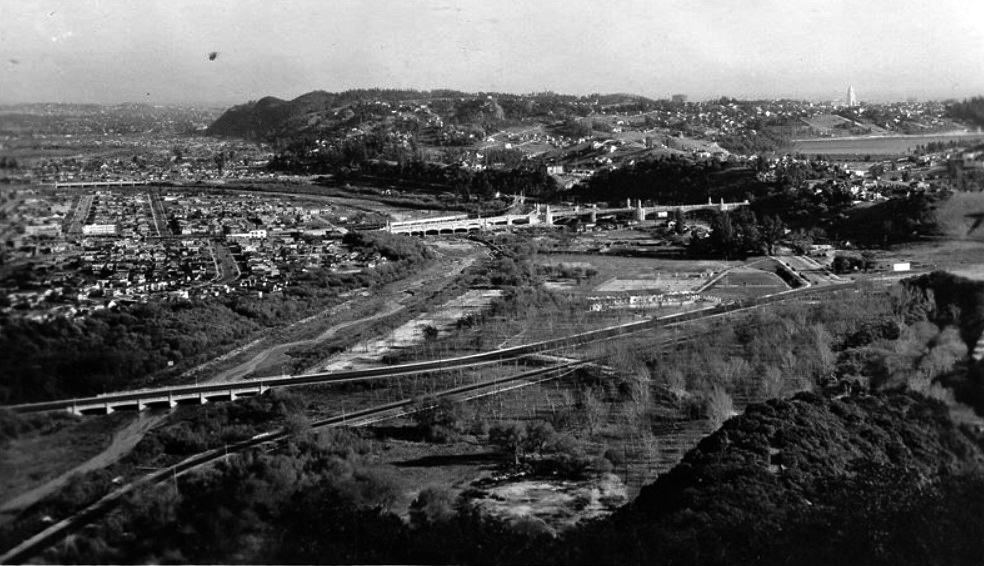 |
|
| (1930)^.^ – View looking southwest showing the newly constructed Glendale-Hyperion Bridge/Viaduct. The farm land/river bottom that runs down the center of the photo is now the home of I-5. In the distance, upper-right corner, can be seen City Hall (built in 1928). |
Historical Notes Frequently asked question: Is it a bridge or viaduct? The answer is that its both a Bridge and a Viaduct. Bridges are structures which are built to cross physical obstacles like a valley, water, or road. Viaducts are a type of bridge that are made of multiple small spans. They have arches in a series. All arches are of almost the same length. |
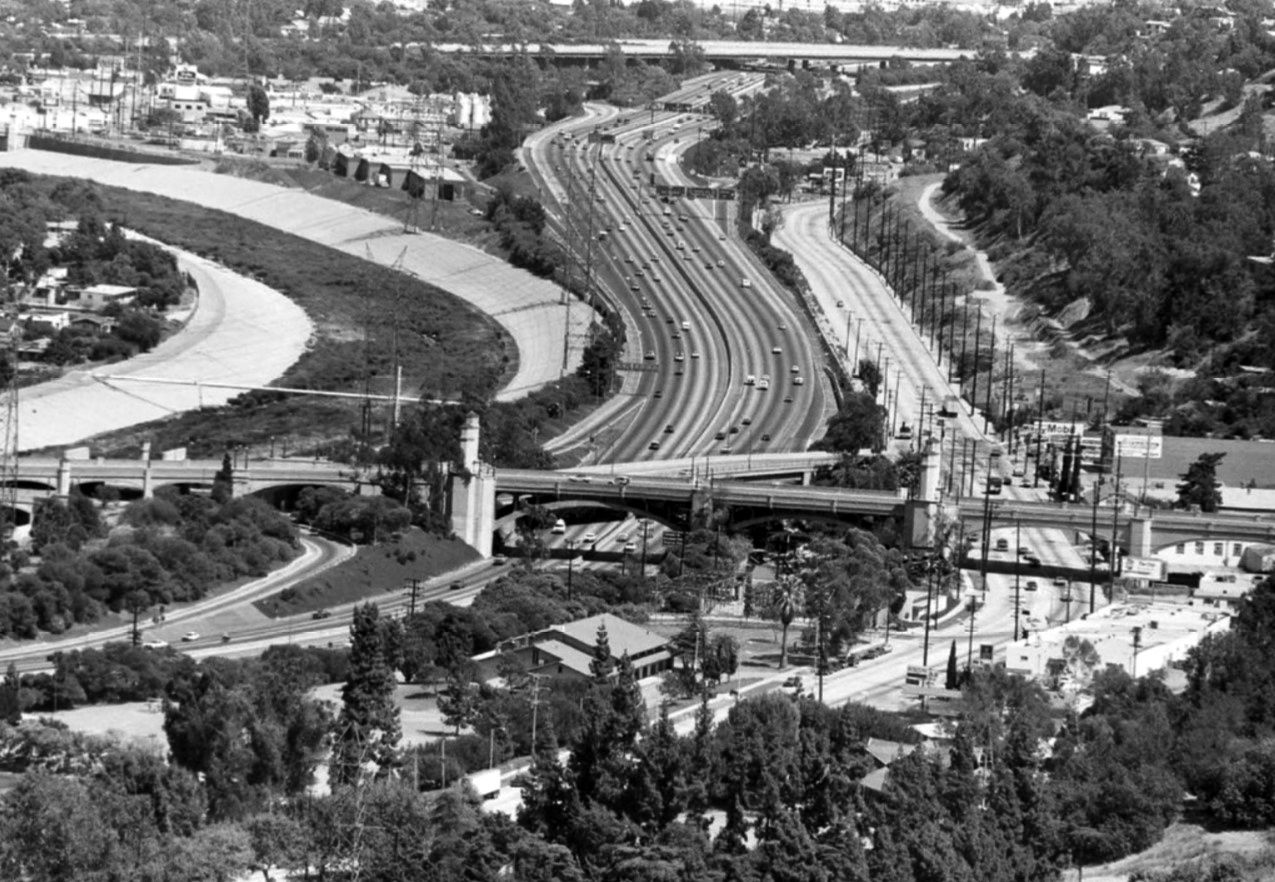 |
|
| (n.d.)^.^ - Closer view of the Glendale-Hyperion Bridge after completion of the Golden State Freeway (1950s), with the L.A. River seen on the left. |
Historical Notes Merrill Butler, Engineer of Bridges and Structures for the city’s Bureau of Engineering from 1923 to 1961, gets the credit as designer of the monument. The total length of the main portion is close to 1,400 feet. Crews used more than 35,000 cubic yards of concrete and 6,000,000 pounds of reinforcing steel in the total construction. They also drove about 1500 wooden and 3200 concrete piles to support the piers and abutments. There are thirteen arches: two are 135-feet each; eight are forty-eight feet; one is sixty-eight feet; and two stretch 118-feet. |
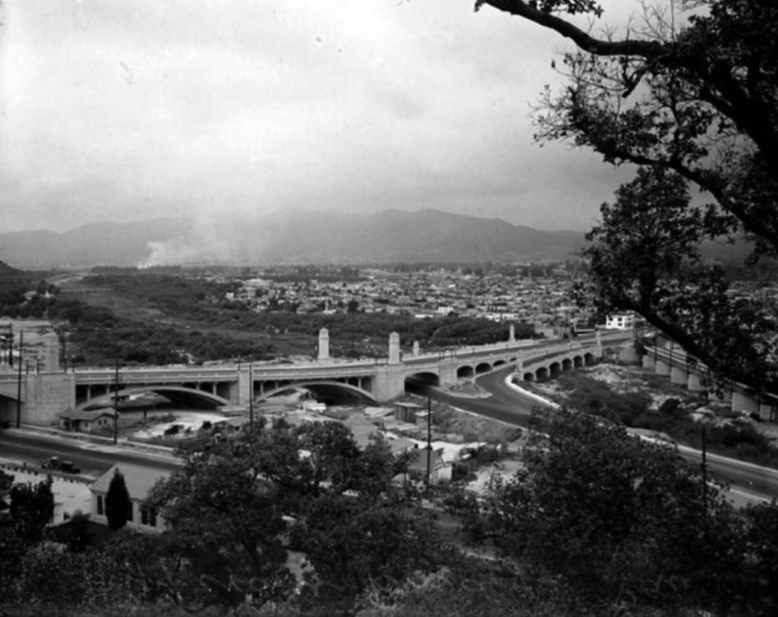 |
|
| (ca. 1930)^^ - View looking NE showing the Glendale-Hyprion Bridge spanning Riverside Drive, Interstate 5, and the L.A. River. |
Historical Notes The black and white shot, above, from the USC Digital Archive, is interesting for a couple of reasons. First, most obviously, it's pre-5. The freeway would go on to plow under one of the bigger arches shown, the one on the right. Also, you can see the Pacific Electric bridge at the far right. |
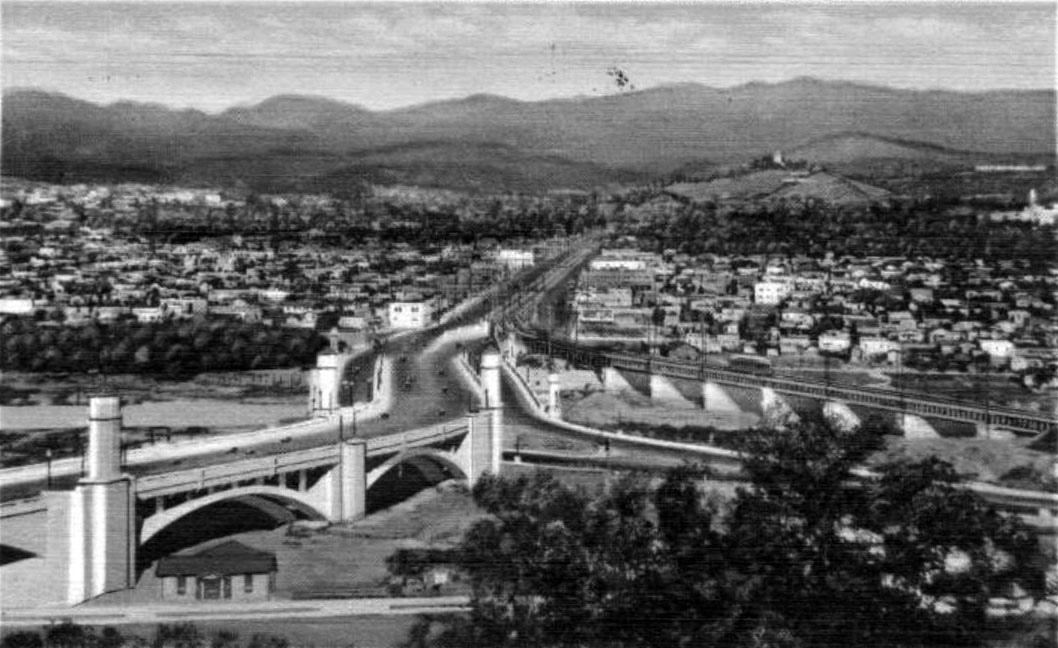 |
|
| (1931)##^* – Postcard view looking east showing the Glendale-Hyperion Viaduct with Red Car seen at center-right crossing a bridge over the LA River. |
Historical Notes In 1929 the Pacific Electric Railway constructed a line next to the Hyperion Bridge that would have Red Cars cross the Los Angeles River and down Glendale Boulevard. Up until 1959 the Red Cars would routinely cross the Los Angeles River next to the Hyperion Bridge. The line was shut down in 1959 in favor of Freeways. Today the concrete walls that held up the Red Car tracks still stand although the tracks have since been dismantled.^* |
 |
|
| (ca. 1930s)*# - Close-up view of the Glendale-Hyperion Bridge shortly after it opened. Note the early model car at center. |
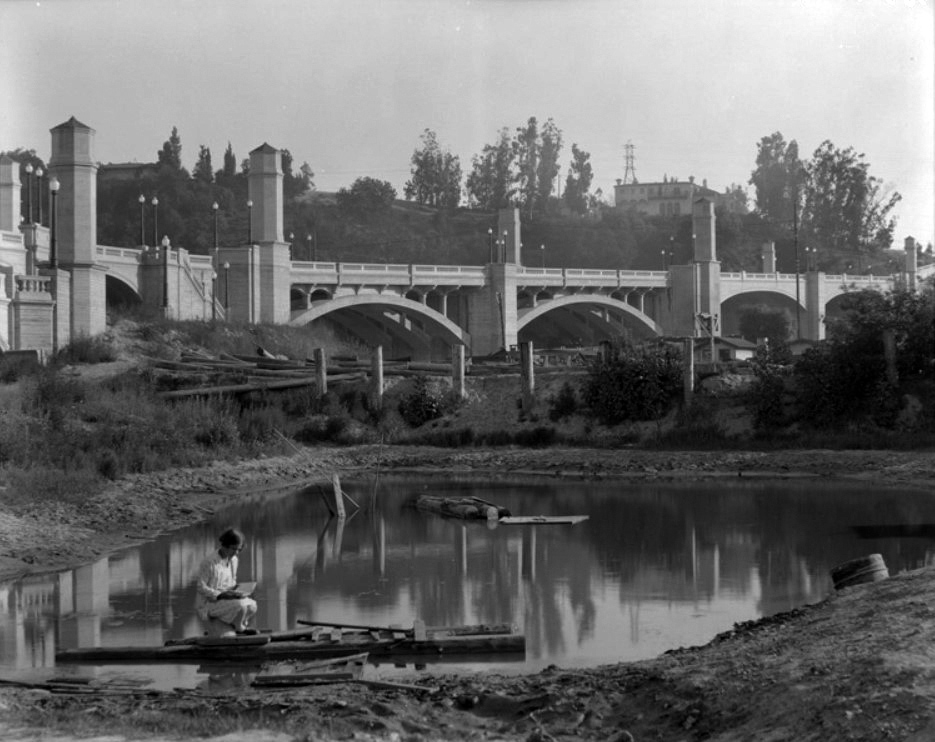 |
|
| (1930s)^ – A woman is seen reading on a make-shift wooden raft floating over a small body of water, part of the L.A. River, with the Glendale-Hyperion Bridge in the background. |
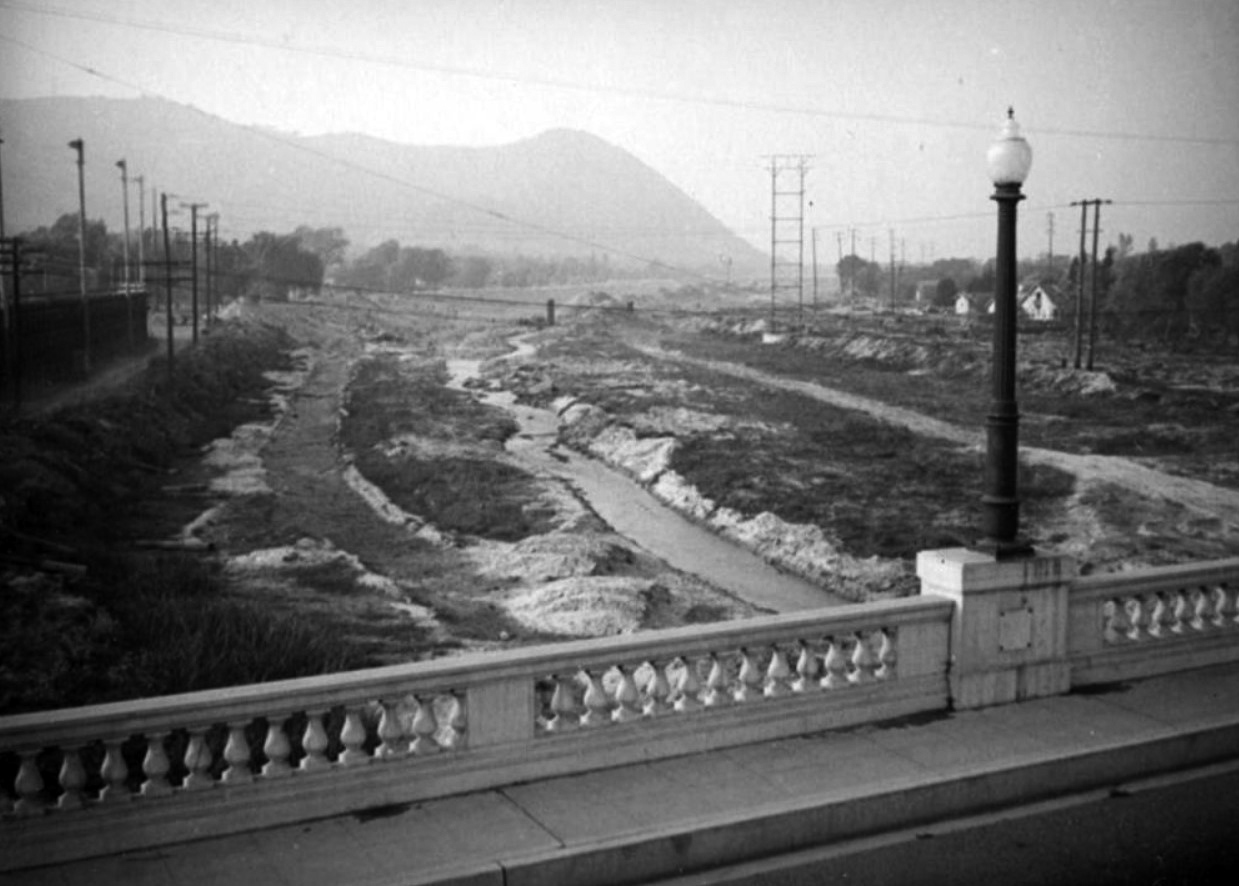 |
|
| (1930s)^ – View looking north from the Glendale-Hyperion Bridge showing the natural bottom of the Los Angeles River. |
Historical Notes Originally an alluvial river that ran freely across a flood plain, the Los Angeles River's 51-mile path was unstable and unpredictable with the mouth of the river moving frequently from one place to the other. In March of 1938 there was a great storm that flooded one third of the city of Los Angeles killing 115 people. Later that year, due to public outcry, the Army Corps of Engineers began the 20 year project to create the permanent concrete channel which still contains most of the of riverbed today. Click HERE to see more in Los Angeles River - The Unpredictable! |
Before and After
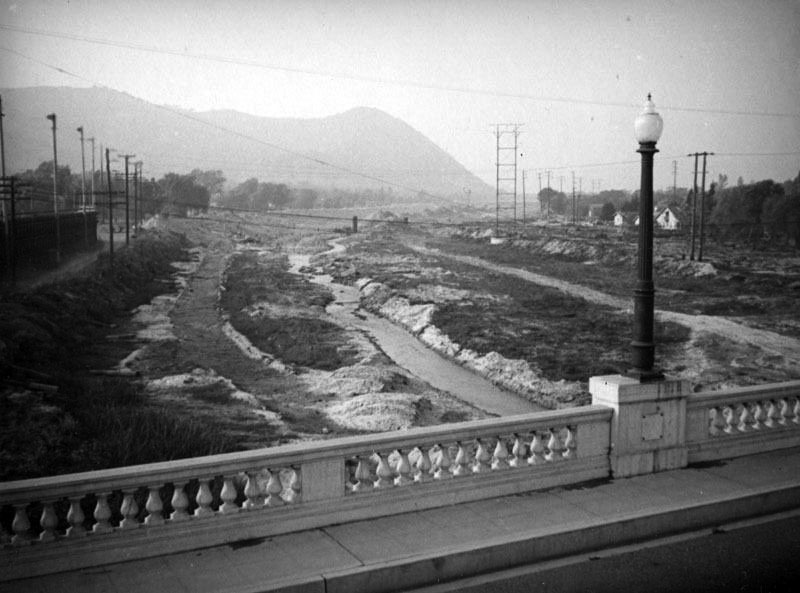 |
|
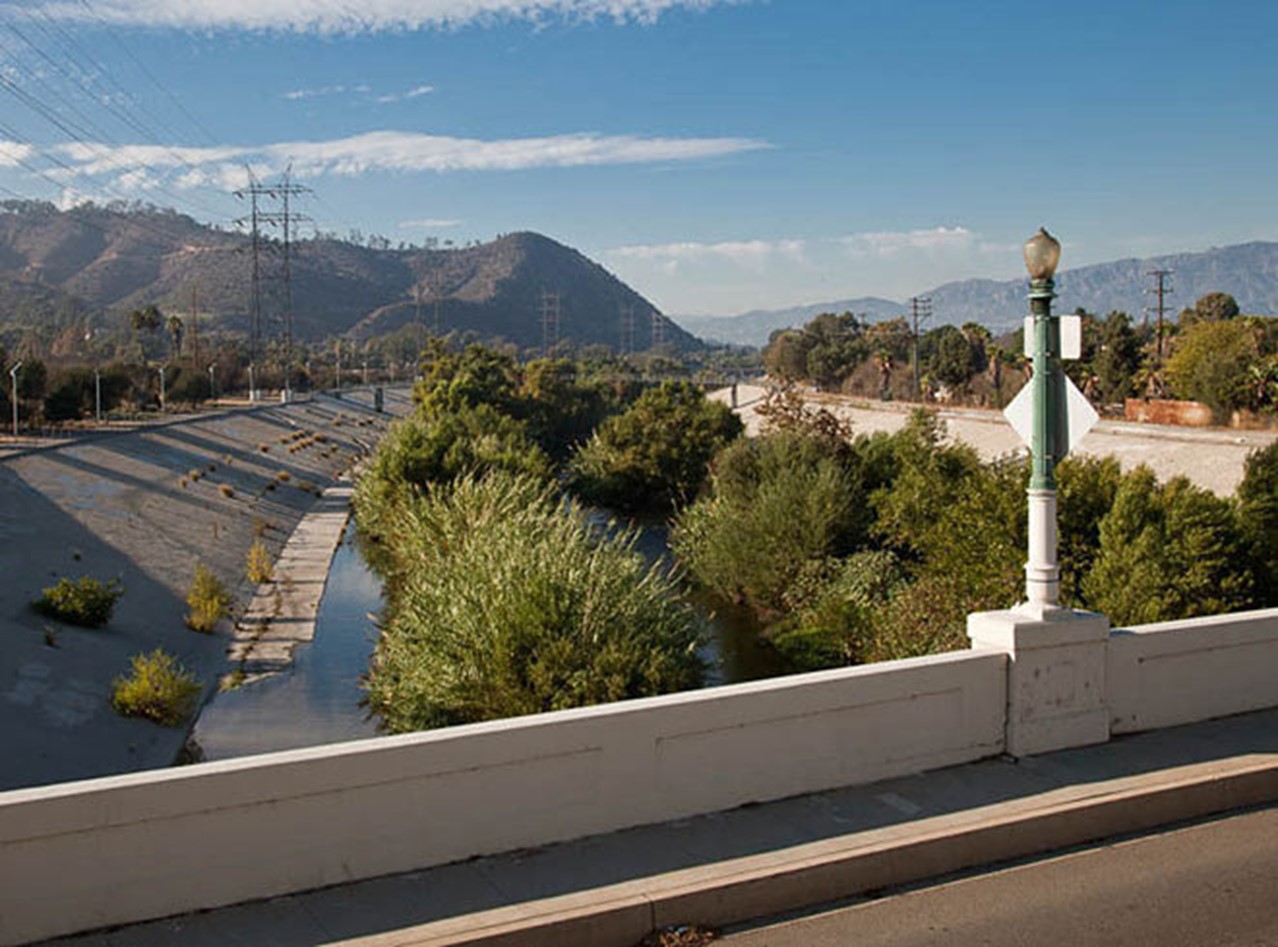 |
|
| (1930s vs. 2015)* - Before and After Los Angeles River Channelization - View from the Glendale-Hyperion Bridge |
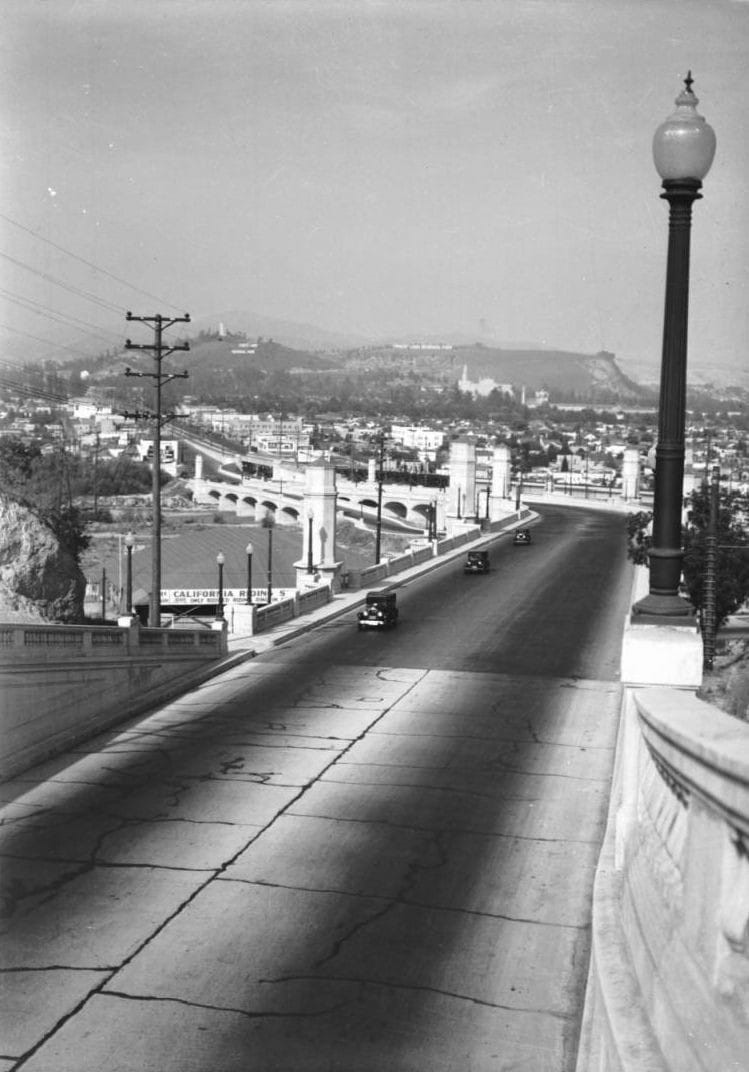 |
|
| (1932)^ - Glendale-Hyperion Bridge; Photo Source: Automobile Club of Southern California |
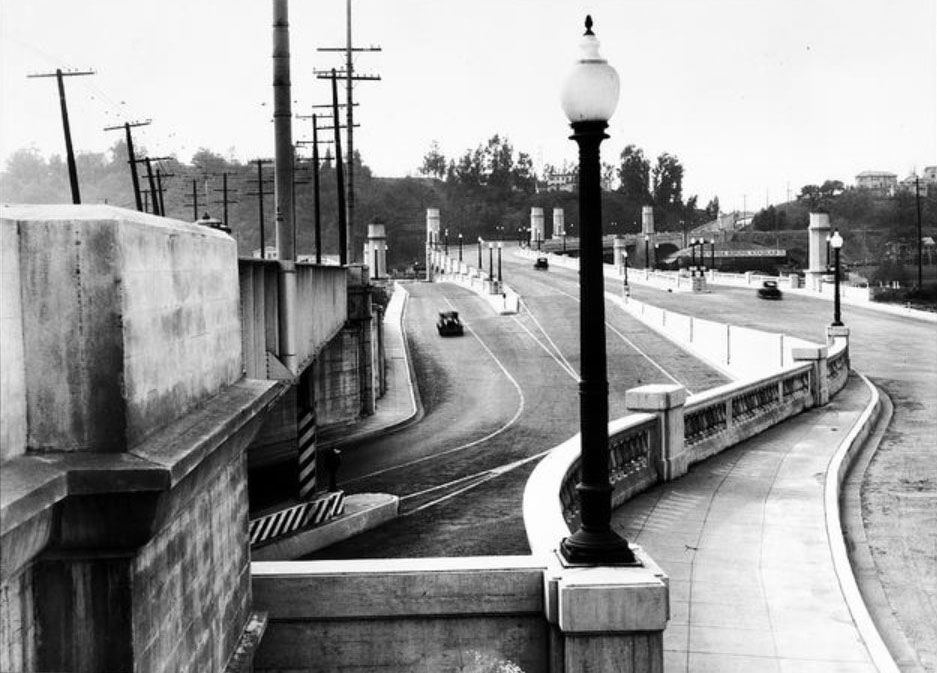 |
|
| (ca. 1935)*# - View looking west showing the Pacific Electric Railway line adjacent to the Glendale-Hyperion Bridge. |
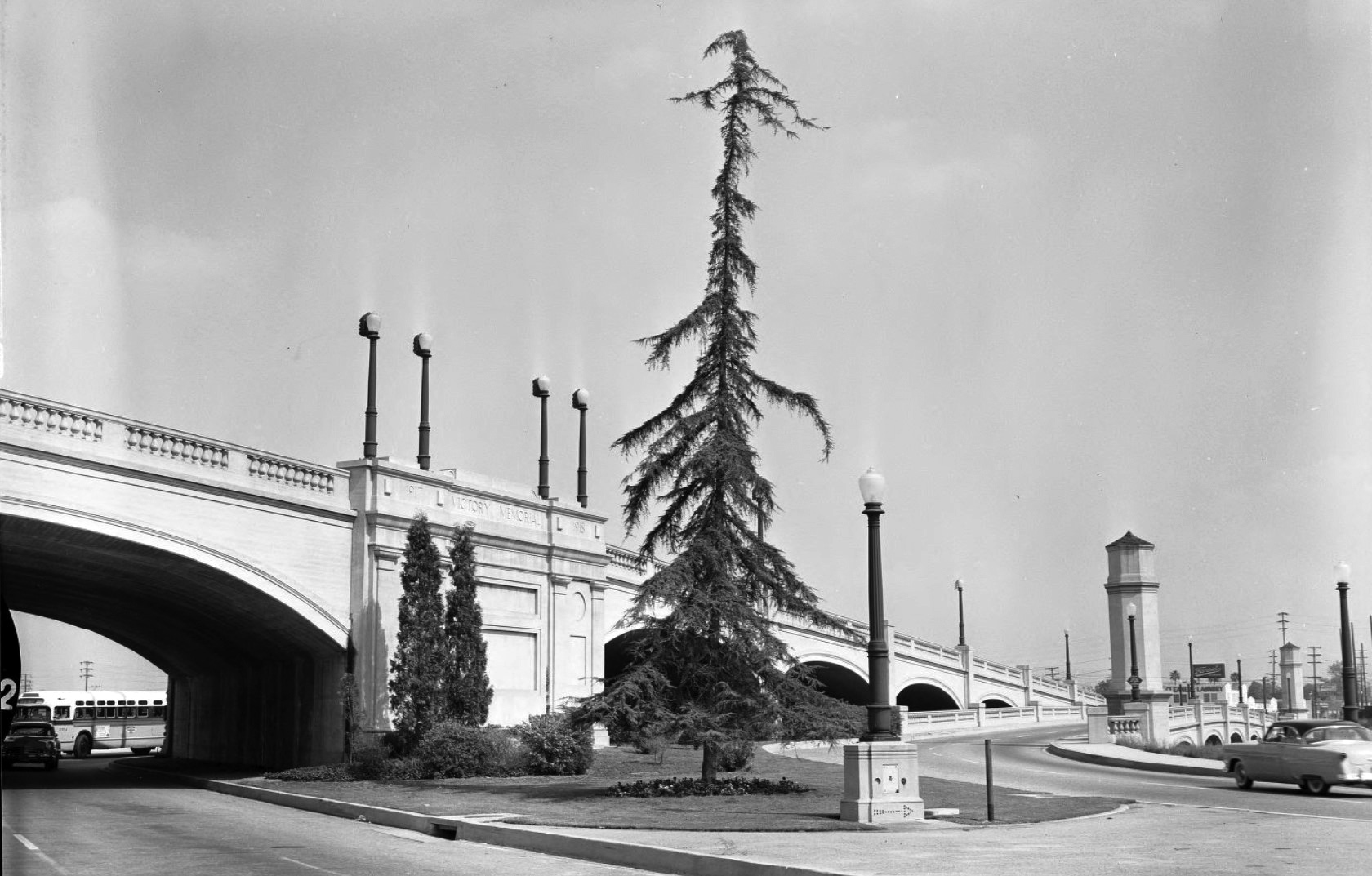 |
|
| (1950s)^ – View showing the eastern end of Glendale-Hyperion Bridge where it swoops down over Riverside Drive near Glendale Boulevard in the Atwater District. |
Historical Notes The 56-ft. wide, 1,370-ft. concrete arch Glendale-Hyperion Bridge was designed by Merrill Butler and completed in 1929; it was originally named the Victory Memorial Bridge, in honor of the men who had served in World War I. It crosses over the Los Angeles River, Riverside Drive, between Ettrick Street and Glenfeliz Boulevard, and since the 1950s, the Golden State Freeway. It is Los Angeles Historic-Cultural Monument #164. |
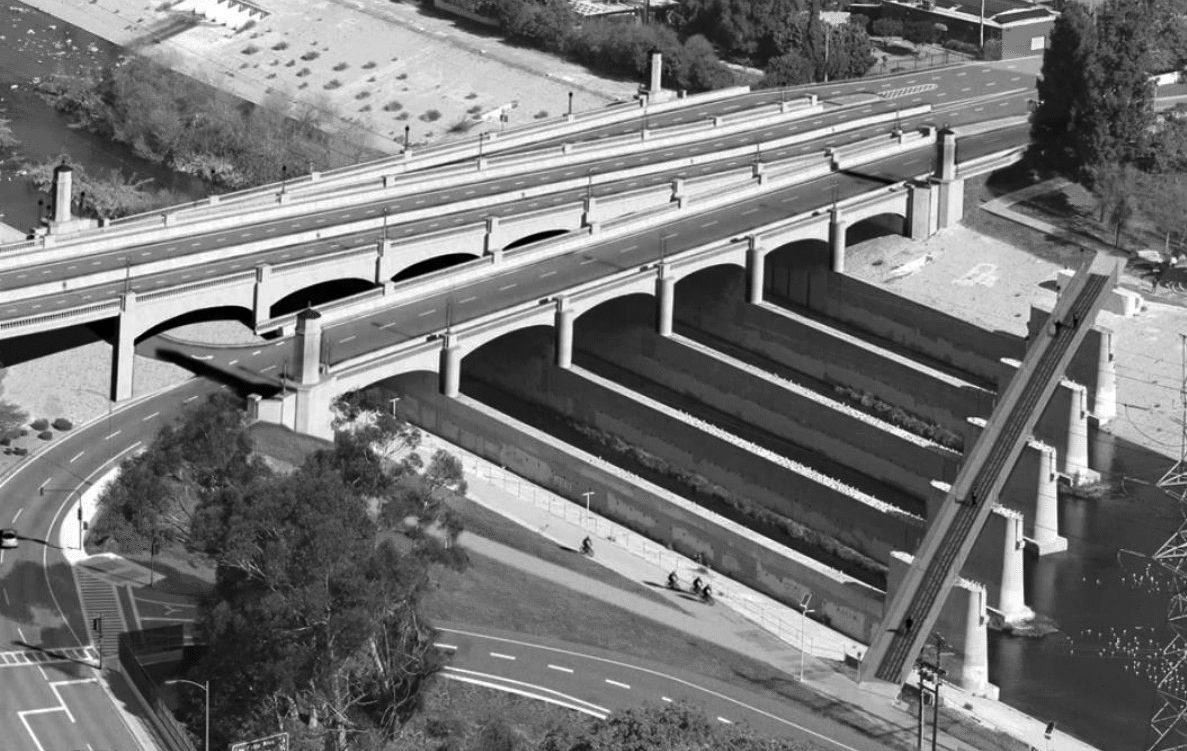 |
|
| (2015)^.^ – Rendering of new pedestrian bridge across the Los Angeles River with the Glendale-Hyperion Bridge seen on the left. |
Historical Notes Today the Glendale-Hyperion Bridge still serves the people of Los Angeles and Glendale by serving as a crossing point between the cities. In 2004 multiple murals were painted on the old Red Car walls. Because of that the area underneath and around the Glendale-Hyperion Bridge is now named "Red Car Park". Prior to 2011, the area underneath the bridge served as an encampment for the local homeless. In 2011, all homeless people were removed as well as all of their belongings. On May 12, 2015, Los Angeles City Councilman Mitch O'Farrell announced that a permanent pedestrian/bicycle bridge would be built atop the old Red Car Pylons, connecting the two banks of the L.A. River. The project was expected to begin in 2018 after the design phase is completed, and will coincide with a retrofitting for the Glendale-Hyperion Complex of Bridges.^* |
* * * * * |
|
Other Sections of Interest |
|
Water and Power in Early LA |
|
Newest Additions |
New Search Index |

A new SEARCH INDEX has been added to help navigate through the thousands of topics and images found in our collection. Try it out for a test run.
Click HERE for Search Index |
* * * * * |
< Back
Menu
- Home
- Mission
- Museum
- Mulholland Service Award
- Major Efforts
- Board Officers and Directors
- Positions on Owens Valley and the City of Los Angeles Issues
- Legislative Positions on
Water Issues
- Legislative Positions on
Energy Issues
- Recent Newsletters
- Historical Op Ed Pieces
- Membership
- Contact Us
- Search Index
© Copyright Water and Power Associates
Layout by Rocket Website Templates